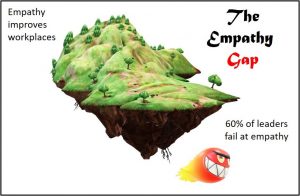
Empathy improves workplaces, but leaders are lousy at it.
Empathy makes work better and employees happier and healthier. But research shows that most leaders and organizations fail at it. Welcome to the empathy gap.
Although the gap is big, there is hope. Proven techniques can encourage and support empathy at work.
This article covers a June 2020 paper in the Consulting Psychology Journal by Kenneth Nowack and Paul Zak titled “Empathy Enhancing Antidotes for Interpersonally Toxic Leaders”.
We’ll start by defining empathy and explaining how it links to leadership, emotional intelligence and kindness. Next we’ll look at the empathy gap. Finally, we’ll explore some techniques for enhancing empathy with individuals and with systems in organizations.
What is empathy?

Empathy – or empathetic compassion/ concern – involves people having positive feelings toward others that can lead to helping behavior and healthier workplaces.
Lack of empathy can result in toxic leadership and stressful workplaces.
Leadership and empathy
Nowack and Zak cite a 2018 study using the McKinsey Organizational Health Index that surveyed 189,000 employees in 81 organizations.
That survey showed empathy to be one of four key leadership practices (along with being collaborative, results-oriented and problem solving) that made a leader effective.
That survey identified four key empathy skills:
- appreciating the inherent value of other people
- treating others with fairness and respect
- interacting with other people
- being collaborative instead of competitive
Effective leaders use empathy at work.
Empathy and Emotional Intelligence

The idea of empathy being a key skill for leaders has been around for awhile – such as in the work on emotional intelligence.
In a ground breaking 2004 Harvard Business Review article titled ‘What Makes a Leader?’, Daniel Goleman introduced the business world to the idea of Emotional Intelligence (EI).
One of Goleman’s five key elements of Emotional Intelligence is Empathy. He describes a leader as displaying empathy when considering the feelings of others when making decisions and appreciating the unique needs of others.
Empathy and Kindness
When the empathy turns into positive action, it becomes kindness. Acting with empathy and kindness does not mean that a leader must sacrifice the needs of the business for employee feelings.
Instead, it means that employee needs and feeling have some weight in decisions and the leader can act and communicate with kindness and empathy.
Check out the article “A Kindness Pandemic” for suggestions of everyday kindness activities such as greeting people, monitoring tone of voice and body language, stop complaining and assuming positive intent.
60% of leaders fail at empathy
Since the research shows the link between empathy and good leadership, emotional intelligence and kindness, the next question is ‘how good are leaders at empathy?”
Research shows that most leaders get a failing grade around empathy.
Development Dimensions International (DDI) published the High Resolution Leadership Report in 2014 hat summarized the assessments of 15,000 leaders from 300 organizations across 20 industries and 18 countries. The DDIreport supported the finding that empathy drives effective leadership.
Their shocking finding was that only 40% of the leaders were rated as proficient or strong in empathy. In other words, 60% of the leaders failed at empathy.
This highlights a serious empathy gap.
The Empathy Gap

The empathy gap forms between the value that empathy can bring to a workplace and the ability of leaders and organizations to show it.
This gap has serious implications for organizations. Poor empathy leads to destructive leadership. Other negative outcomes can include high turnover, absenteeism, lawsuits, low job satisfaction and poor behavior at work.
Beyond workplace issues, lack of empathy can actually lead to death. One long-term study followed 820 healthy adults for 20 years. It showed that the participants were 2.4 times more likely to die if they had poor workplace relationships.
Other studies link poor working relationships to high blood pressure, higher absenteeism due to illness and higher risk of heart disease.
The empathy gap threatens success at work and in life.
Techniques to enhance empathy
Closing the empathy gap involves improving skills and updating organizational systems.
Develop existing employees
Every person demonstrates different levels of empathy based on personality, experience, history and personal situation. However, some proven techniques can help improve empathy for employees.

Training
People can learn to take a more empathetic mindset through group training.
Training can involve building awareness of empathy, understanding why it is important and doing exercises to connect feelings of empathy with success on team goals.
People can also learn approaches such as perspective-taking – imagining themselves in another person’s situation – which increases awareness and makes empathy more personal.
Executive Coaching
For a more concentrated experience than training, executive coaching can enhance empathy.
Coaching allows for formal measurement of an individual’s empathy through an emotional intelligence assessment.
These results create self-awareness, guide discussion and lead to individualized, on-the-job development.
Meditation

Meditation, such as loving-kindness meditation, encourages people to think about someone for 10-20 minutes a day and focus on feelings of compassion and care.
This can actually reduce stress and stress hormones while also leading to positive behaviors.
Using systems to encourage empathy
Sometimes it is not enough to train individual leaders. Organizations must change some of their core systems to encourage and sustain empathy.
Expect empathy
One way to increase empathy in a workplace is to simply start expecting it. Set a norm for empathy and demonstrate it as a role model.
Address bullying

Empathy won’t survive in an environment that allows bullying and negative behaviors.
It’s time to stop allowing abusive behavior from anyone – even the top producers or senior leaders.
Modify hiring and promotion criteria
Many companies have consciously or unconscious set certain criteria for hiring and promotions that favor assertiveness, charisma and arrogance.
Examine the company criteria – refocus to hire and promote people who show both strong performance and respect for others.
Roll out diversity & inclusion initiatives
Many Diversity & Inclusion initiatives tackle empathy since they teach respect for difference and reducing bias.
As a company, you can address racial and gender disparities while also promoting empathy.
Demonstrate appreciation
Showing appreciation to colleagues acknowledges the inherent worth of other people.
Simple appreciation promotes empathy, increases employee self-esteem and helps alleviate work stress.
Simple equation to solve the empathy gap
Leaders and organizations can cultivate empathy through leadership behaviors, programs and organizational systems.
Research indicates that empathy can improve retention, workplace stress, and even physical health.
Simple changes = more empathy = happier work.
Can your company close the empathy gap with that equation?
Researchers
Ken Nowack, Envisia Learning, Inc.
Paul Zak, Claremont Graduate University
Nowack, K., & Zak, P. (2020). Empathy enhancing antidotes for interpersonally toxic leaders. Consulting Psychology Journal: Practice and Research. doi: 10.1037/cpb0000164




Pingback:August 2020 Leadership Development Carnival - Lead Change